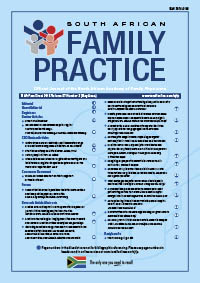Caffeine <i>versus</i> aminophylline for the prevention of apnoea of prematurity in a teaching hospital in South Africa
Keywords:
Caffeine, Aminophylline, Apnoea of Prematurity (AOP), Neonates
Abstract
Study objectives: To determine the safety and efficacy of the use of oral anhydrous caffeine and intravenous aminophylline in the neonatal population using therapeutic drug levels and clinical effects as markers for determination. Design: Prospective randomised study. Patients: Thirty-one neonates admitted (aminophylline n = 16, caffeine n = 15) with a gestational age of less than or equal to 34 weeks for prevention of apnoea of prematurity (AOP) were enrolled. Results: Oral anhydrous caffeine or intravenous aminophylline were administered using prescribed study regimens. One peak level was taken for the two drugs on day 4 of treatment 2 hours after the maintenance dose was administered. The two regimens were clinically monitored using cardiovascular, respiratory, gastro-intestinal and central nervous system parameters four hourly. The two groups did not differ significantly for gestational age (p = 0.782), birth weight (p = 1), gender (p = 0.722), and Apgarscores determined at 5 minutes (p = 0.068). Serum concentrations were within range (5–20 μg/ml) for both study groups. The median pulse rate (beats per minute) for two days; day 7: 160 vs. 148 (p = 0.019); day 9: 168 vs. 147 (p = 0.020) and median respiratory rate (breaths per minute) for five days; day 3: 68 vs. 61 (p = 0.039); day 4: 67 vs. 57 (p = 0.014); day 5: 64 vs. 58 (p = 0.045); day 7: 65 vs. 50 (p = 0.021); day 8: 66 vs. 56 p = 0.014) were significantly higher in the aminophylline study arm. Conclusion: The findings of the study indicated that caffeine is an effective alternative for intravenous aminophylline in prevention of AOP. The oral administration of caffeine may also have an advantage in a resource-poor setting. (Full text available online at www.medpharm.tandfonline.com/ojfp) S Afr Fam Pract 2015; DOI: 10.1080/20786190.2014.983310
Published
2015-07-10
Section
Research Articles
By submitting manuscripts to SAFP, authors of original articles are assigning copyright to the South African Academy of Family Physicians. Copyright of review articles are assigned to the Publisher, Medpharm Publications (Pty) Ltd, unless otherwise specified. Authors may use their own work after publication without written permission, provided they acknowledge the original source. Individuals and academic institutions may freely copy and distribute articles published in SAFP for educational and research purposes without obtaining permission.

